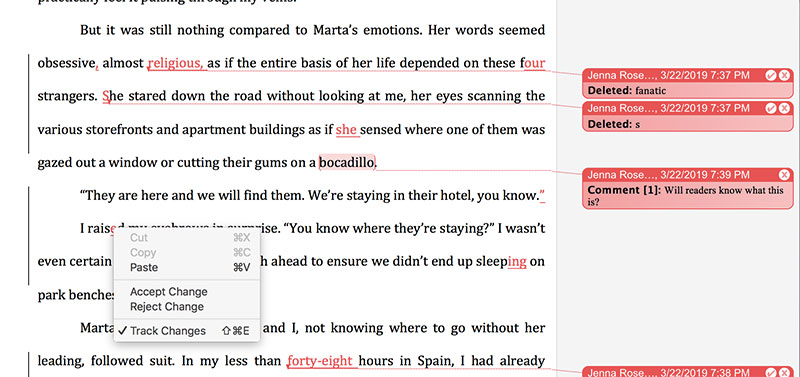Last Updated on April 10, 2023

Now that you've written what you're going to write and you've researched and hired a professional editor to get your material ready for prime time, what's next? Before your book (or article, story, blog, or manuscript) is ready to launch, expect a spate of back-and-forth discussion, questions, and calls for clarification — because that's what those sharp editorial eyes are there for. But as that process unfolds, there are a few things you can do to ensure maximum efficiency and avoid timeworn editorial beefs, not to mention hours of wasted time (and your money).
Here are some tips and guidelines based on the most common practices followed by editors.
Use Microsoft Word
Unless you're asked to do otherwise, deliver the document to your editor as a Microsoft Word document. That's the industry standard for most manuscripts (except screenplays, which are usually written in Final Draft).
And if you're serious about your writing project, spring for the latest version of Word. There's nothing worse than having incompatible files because you and your editor are using versions with a generation gap. The software is no longer as expensive as it once was: For less than $10 a month, you can subscribe to Microsoft Office to always have the most recent version of the software.
Learn Track Changes, the Magic Editing Feature
This all-time-best editing tool has revolutionized the editing process. It is the silver bullet that is a favorite of professional editors, and it will serve you both well.
The application's functionality is a way to keep track of the changes you or your editor make to a document: deletions, insertions, comments. You can then choose whether to accept or reject any or all of them. And you can, with a mere click and toggle, choose to either read the piece with the edit markups in view or hide them so that the edited piece appears “clean.”
With the Track Changes feature on, if some text is deleted, it won't disappear from the document but instead will, depending on the version of your software and your settings, either be crossed out or appear in a balloon in the margin and clearly marked “Deleted.” Added text will be underlined or in a contrasting color. Nothing will be changed permanently until you or the editor decide to accept the changes — which you can do one by one or in one fell swoop.
Because there are so many versions of Word, for both Mac and PC, there are also different ways to access this feature. However, for the majority of versions, you can do so in the following way:
- In Word, go to the upper nav bar, click on “Tools” or “Review” (depending on your version).
- In the resulting dropdown or ribbon, go to “Track Changes,” then slide across to “Highlight Changes.” The “Track Changes While Editing” default should be in place.
- In the resulting pop-up, click the “Highlight Changes on Screen” box to see edits as they're being made or once they've been made; unclick it to view a clean edited version. Retrace your steps to toggle back and forth as you like.
- If you want to continue editing or commenting on something you have received that's already been edited in Track Changes, just click “Track Changes While Editing” again. (Your edits will likely come up in a different color to be distinguishable from the first editor's.)
- To accept changes, click “Review” in the upper Track Changes ribbon, then look for the “Changes” section and the green circle with the white check mark in it. You can then accept all changes at once or one at a time, but my recommendation would be for you to read through the clean edited document as is and make your own adjustments as you go along, so that in the end you can accept all changes, including your own adjustments to the edits.
If this seems complicated, just give it some time. Not only will learning how to use this feature save you from making egregious mistakes, it will save you money by streamlining, clarifying, organizing, and confirming the ongoing conversation between you and your editor, as well as locking in whatever decisions you both have made.
See for yourself what this looks like by checking out one of these online tutorials:
For Word 2016:
https://www.laptopmag.com/articles/make-word-2016-show-changes
For Word for Mac (newer and older versions):
Use Word's Comments Feature
Have something to say or ask about a change the editor made? It's best to do this via the helpful Comment feature, accessible in many versions by highlighting the word(s) or section in question and then clicking “Review” and then “New” under “Comments.” A balloon will appear in the margin in which to express your thoughts. It's a great improvement over writing in-line comments, which will interrupt the flow of your material, possibly get confused with the actual text, and ultimately mess with your word count.
Maintain One Master Document
If there's one thing that's sure to drive your editor nuts (and your invoices up), it's confusion about exactly which version you're working on and the location of the Master Document. This is most typically the result of not renaming the documents as you both flow through the process. For this reason, it is critical that each newly edited or revisited document get renamed before it gets saved.
One common naming method that I prefer is to include your (or your editor's) initials and a date (or version number) in the file name. For example: HarryPotterPartXIII-JKR2-KZ1.docx. Then, when I make edits, the file I'd send back to JKR would read: HarryPotterPartXIII-JKR2-KZ2.docx.
This way, the editor can integrate all decisions into a single master document — which she is traditionally the keeper of. Untold war stories (and we editors have heard them all) revolve around carefully updated versions that have gotten lost, requiring great gusts of time and energy to figure out which is which and where the latest version lies. As you begin work with your editor, agree on your naming convention and then stick with it, and let there be but one Master in your universe!
More About Getting the Best From Your Editor
Learn how to make the most of this important relationship from the pros:
The Writer-Editor Relationship
Understanding What Editors and Copyeditors Do
- Why You Need an Interior Designer for Your Self-Published Book - June 7, 2022
- 6 Reasons Why You Should Write Your Book in Microsoft Word - December 8, 2020
- Tricks of the Editing Trade: Word, Track Changes, and the Master Document - May 16, 2019




One Comment
Kate, I commend you for writing this explosive blog post! I agree with you, totally, on every aspect of content you shared. I don't think anyone else could've written it any better. I admire your genius. Thanks, for being thorough in sharing your knowledge with the world.